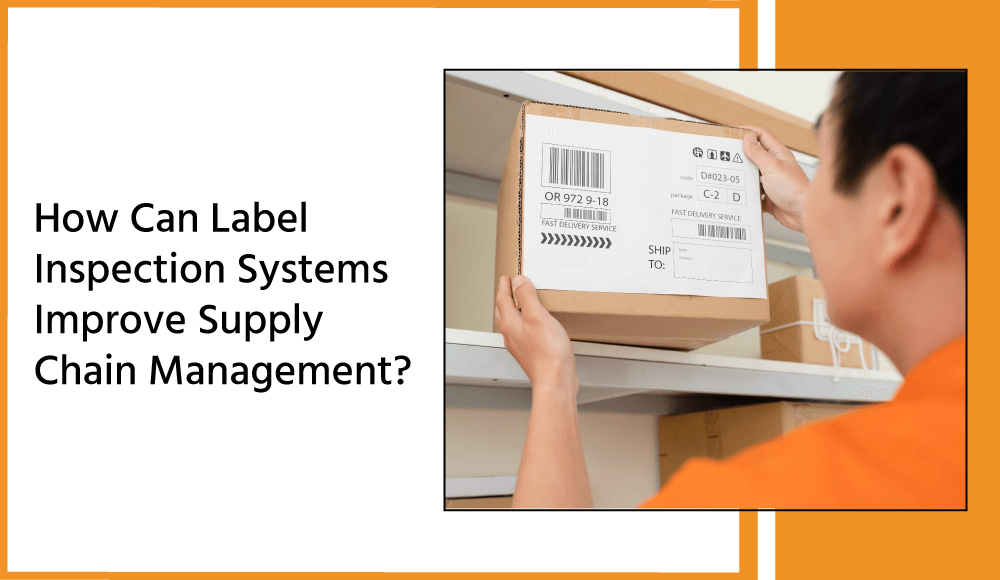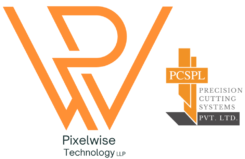
- Pixelwise Technology
- Jun 1, 2023
- Label inspection
Label inspection system is a machine vision-based system that inspects labels, print quality, and packaging applications to ensure accuracy, readability, data verification and enhance traceability. It uses an image sensor that integrates lens, light, and image acquisition. This can spot defects, verify a product’s contents match its label, and analyse mislabeling errors by catching mistakes early in the production process.
The implementation of a label inspection system in supply chain management plays a pivotal role in facilitating the seamless flow of goods, services, and information throughout the sector. By optimising operational efficiency, reducing costs, and enhancing customer satisfaction, it serves as a valuable tool in ensuring a streamlined and successful supply chain ecosystem.
Let us explore the benefits, key features, different types and challenges of implementing label inspection systems in supply chain management.
Transform your supply chain with cutting-edge label inspection systems. Elevate efficiency – Explore now!
A] Benefits of Label Inspection Systems in Supply Chain Management
1. Ensures Accurate Labelling Of Products
Label inspection systems verify product labels for accurate information, including ingredients, nutritional facts, warnings, and barcodes. It reduces the risks of mislabeling, enhances customer trust, and ensures compliance with regulations, promoting safety and satisfaction.
2. Enhances Traceability And Reducing The Risk Of Counterfeit Products
Label inspection systems track and verify labels, improving supply chain visibility. They mitigate the risk of counterfeit products by ensuring label authenticity, protecting brand reputation, consumer safety, and revenue with genuine products reaching the market.
3. Improving Compliance With Regulatory Requirements
These systems help companies meet industry-specific labelling standards and comply with regulations related to allergen warnings, nutritional facts, and other mandatory information. It reduces the risk of legal issues and penalties and showcases a commitment to meeting industry-specific regulations.
4. Preventing Recalls And Reducing Waste
Label inspection systems specialise in spotting defects during production, preventing mislabeling and expensive recalls, leading to reduced waste. By detecting errors at an early stage, these systems save valuable time, money, and resources. This not only promotes a more sustainable supply chain but also enhances efficiency by minimising the need for corrective actions.
5. Enhances Customer Satisfaction And Brand Reputation
Label inspection systems enhance customer satisfaction and brand reputation by ensuring accurate and reliable product labelling. With correct information on labels, customers can make informed choices, leading to increased trust and satisfaction. This fosters positive brand experiences and strengthens the reputation for delivering quality products.
B] Types of Label Inspection Systems Used in Supply Chain Management
1. Vision-Based Label Inspection Systems
Vision-Based Label Inspection Systems employ cameras and image processing software to inspect labels for quality control purposes. It captures high-resolution images of labels and utilises image processing algorithms to verify label accuracy, readability, print quality, and overall label condition. The label numbering inspection system offers a high-speed camera to ensure labels have correct, sequential numbering for product identification, traceability, and inventory management.
2. Barcode And Qr Code Scanners
Barcode And Qr Code Scanners are designed to scan and decode barcodes and QR codes on product labels. Optical sensors or laser scanners are used to quickly and accurately read the encoded information on labels. The 1D and 2D code verification systems can connect to up to 4 cameras and read each barcode at a speed of 40 reads per second. This ensures that the labels have the correct codes and enables efficient inventory management, traceability, and product tracking throughout the supply chain.
3. Radio Frequency Identification Systems (RFID)
RFID systems use radio frequency technology to identify and track labels or tags attached to products. When an RFID reader emits radio waves, it activates the RFID tags within its range, allowing the system to gather information about the labelled products. This technology provides real-time data capture, which leads to precise inventory management, efficient asset tracking, and enhanced visibility throughout the supply chain.
4. Machine Learning-Based Label Inspection Systems
Machine learning-based label inspection systems use artificial intelligence algorithms to improve the quality and efficiency of printed label inspection. By continuously learning and adapting, they can detect and classify label defects and anomalies with high precision. This technology enables more robust and automated label inspection processes.
5. Integration With Automation And Robotics
This method revolutionises label inspection systems, making them more efficient and precise. Combining cutting-edge label inspection technology with automated machinery and robotic systems streamlines and optimises the inspection process. This integration ensures that labels attached to products satisfy quality and precision requirements. As a result, manual labour is reduced, reducing the likelihood of human error and substantially enhancing process efficacy overall.
C] Key Features of Label Inspection Systems
1. Verification Of Label Information
Label inspection systems play a crucial role in verifying the accuracy and integrity of label information. They ensure that essential details, such as the product name, batch number, expiration date, manufacturing date, and any other relevant information, are correctly represented on the label. By cross-checking the label information against provided data, these systems ensure consistency, compliance, and reliable product identification.
2. Verification Of Label Placement, Alignment, And Orientation
Label placement, alignment, and orientation are critical factors for effective labelling. The system examines these aspects to ensure that labels are properly positioned and aligned according to predefined standards. By verifying label placement, these systems prevent mislabeling, incorrect orientation, or skewed positioning, which can affect barcode scanning, readability, and overall visual appeal.
3. Verification Of Label Quality
The quality of labels significantly impacts product presentation and readability. Label inspection systems are equipped to evaluate various aspects of label quality, including print quality, legibility of text, clarity of graphics, and readability of barcodes and QR codes.By verifying printing parameters, such as ink density, font size, and barcode specifications, these systems guarantee visually clear and easily scannable labels, ensuring optimal product presentation and effective information retrieval.
4. Real-Time Data Collection And Analysis
Label inspection systems enable real-time data collection during the inspection process. This means that as labels are inspected, relevant data and metrics are captured and analysed immediately. Real-time data analysis provides instant feedback on label quality, placement, and other parameters, allowing for prompt corrective actions and preventing issues from escalating.
5. Integration With Enterprise Resource Planning Systems
Label inspection systems offer seamless integration features with enterprise resource planning systems. This integration enables efficient data exchange and synchronisation between the label inspection system and the central ERP system. Inspection data, results, metrics, and analytics, can easily be shared with the broader organisation. This enhances traceability, facilitates better decision-making, and supports process optimization throughout the supply chain.
D] Challenges And Considerations For Implementing Label Inspection Systems
1. Cost And ROI
When implementing a label inspection system in supply chain management, it involves investing in equipment like scanners, cameras, and software licences. Evaluating the return on investment is crucial by considering costs and weighing them against the expected benefits. It’s important to establish a realistic budget to ensure the investment brings significant improvements to supply chain efficiency and accuracy.
2. Integration With Existing Production And Supply Chain Processes
Integrating label inspection systems with existing production and supply chain processes in the supply chain industry is complex. It involves seamlessly aligning the system with workflow, equipment compatibility, and coordination with IT, production, and supply chain teams. Thorough planning, clear communication, and collaboration are key to minimise disruptions and enhance workflow efficiency during the integration process.
3. Training And Expertise Required For System Operation And Maintenance
When introducing label inspection systems into the supply chain industry, it is essential to have trained and knowledgeable staff who can handle system operation and maintenance. These staff members need to understand the system’s features, diagnose and address any problems that may arise, and ensure its smooth operation. Regular maintenance and comprehensive training are vital to prevent system failures and enhance performance, resulting in better accuracy and efficiency throughout the supply chain.
4. Choosing The Appropriate System
Selecting the right label inspection system that aligns with specific supply chain requirements is critical. It involves evaluating various factors such as label type, production volume, inspection capabilities, and integration with existing infrastructure. Conducting research, consulting experts, and conducting trials can ensure the chosen system meets the specific supply chain needs. The right selection can lead to improved accuracy, reduced errors, increased productivity, and enhanced overall efficiency.
5. Data Privacy And Security Considerations
Data privacy and security are critical in the supply chain industry when using label inspection systems. These systems handle sensitive information, like product details and customer data. Implementing strong security measures, following regulations, using robust passwords and encryption, and monitoring system activity protects the data from unauthorised access and builds trust among stakeholders. When data is kept safe, it builds trust among customers, suppliers, and other stakeholders in the supply chain, leading to stronger relationships and a more reliable supply chain ecosystem.
Transform your supply chain with cutting-edge label inspection systems. Elevate efficiency – Explore now!
Conclusion
Implementing label inspection systems can transform your supply chain management, revolutionising accuracy, productivity, and efficiency. By integrating these systems, businesses can reduce errors, avoid disruptions, and maintain regulatory compliance. This proactive approach will optimise operations, enhance customer satisfaction, and position organisations ahead of the competition in today’s fast-paced and ever-changing supply chain landscape.
Don’t let inaccurate labelling disrupt your supply chain. Get in touch with our experts today and discover how our label inspection systems can streamline your operations and improve efficiency.





